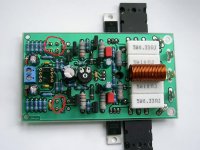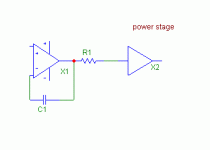Bo, I had 2MHz oscillations too, when I built Lynx first time. You must find best values for your OPA. Some OPA need other value of C102, 103 and 109.
Some little table for my version of Lynx:
OPAMP C109 C102/103
__________________________________________
OP27 100p 100p
__________________________________________
LME49710 33p 220p
__________________________________________
NE5534 82P 220p
__________________________________________
LT1128 82p 180p
__________________________________________
NE5534:
No load
4 ohm load
4 ohm load + 4uF foil capacitor paralell
2kHz square. Sorry for quality
Some little table for my version of Lynx:
OPAMP C109 C102/103
__________________________________________
OP27 100p 100p
__________________________________________
LME49710 33p 220p
__________________________________________
NE5534 82P 220p
__________________________________________
LT1128 82p 180p
__________________________________________
NE5534:
No load
An externally hosted image should be here but it was not working when we last tested it.
4 ohm load
An externally hosted image should be here but it was not working when we last tested it.
4 ohm load + 4uF foil capacitor paralell
An externally hosted image should be here but it was not working when we last tested it.
2kHz square. Sorry for quality
masteramp:
Do you mean C109 = 33pF and C102/C103 = 220pF?
Earlier you said that you got the best square-wave response with the Miller-caps (C102 and C103) at 100pF.
It would be great if you would clarify.
Best regards,
/Bo
Do you mean C109 = 33pF and C102/C103 = 220pF?
Earlier you said that you got the best square-wave response with the Miller-caps (C102 and C103) at 100pF.
It would be great if you would clarify.
Best regards,
/Bo
With 100pF is square better than with 33pF in all cases. 100pF are the best for OP27. Yesterday I measured and tuned Lynx again. For faster OPAs are values higher, but not more than 330pF . Here is a table of my tuned values. If amplifier always oscillates, voltage gain should be lower (you must increase value of R121).
I have newer build an original Lynx with original PCB. With this values works my version of Lynx!
I have newer build an original Lynx with original PCB. With this values works my version of Lynx!
This is getting really annoying.
In my attempts to get rid of the oscillations, I now have 330pF as miller caps and tried 33pF and 100pF as C109. Didn't help, it only lowered the amplitud to about 2Vpp, but it's still there.
Then I tried uping the R121 as per masteramp (1K), but it got worse (5Vpp), so I tried lowering it to 180R, which got it smaller yet but still existing.
Do I have to swap the OP-amp? Or should I try some lower value miller caps, say 220pF? Or can I go even lower on R121 or higher on R120?
Best regards,
/Bo
In my attempts to get rid of the oscillations, I now have 330pF as miller caps and tried 33pF and 100pF as C109. Didn't help, it only lowered the amplitud to about 2Vpp, but it's still there.
Then I tried uping the R121 as per masteramp (1K), but it got worse (5Vpp), so I tried lowering it to 180R, which got it smaller yet but still existing.
An externally hosted image should be here but it was not working when we last tested it.
Do I have to swap the OP-amp? Or should I try some lower value miller caps, say 220pF? Or can I go even lower on R121 or higher on R120?
Best regards,
/Bo
330pF is high value, but with some OPAs... I recommend to use a smaller value. Higher doesn´t at all times better. Is important to use optimal value, not so low but not so high. Could you place here photos of square signal? Square signal is better for appreciation of stability.
There is no square signal. This is a self-oscillating problem. In fact, the input has been grounded (by a jumper) the whole time.
Best regards,
/Bo
Best regards,
/Bo
bomellberg said:
Do I have to swap the OP-amp?
This should help, if it would have been used.
What opamps do you have? Try the slow and stable type, like OP27.
Attachments
Stable!!
OP: 471 with 33p on the millers and 100p on C109. I know this OP is really shitty but now I can adjust the bias at last!
Only problem seems that it draw too much current. My fuses (0.5A fast) blow as I adjust tpA - tpC to more than 1V. Should it be necessary with bigger fuses on the input stage?
Thanks for all help. I just wish I could get it working with the LM49710 as I have good experience from that OP in audio cards for HTPC. Well, you can't have it all it seems.
Best regards,
/Bo
OP: 471 with 33p on the millers and 100p on C109. I know this OP is really shitty but now I can adjust the bias at last!
Only problem seems that it draw too much current. My fuses (0.5A fast) blow as I adjust tpA - tpC to more than 1V. Should it be necessary with bigger fuses on the input stage?
Thanks for all help. I just wish I could get it working with the LM49710 as I have good experience from that OP in audio cards for HTPC. Well, you can't have it all it seems.
Best regards,
/Bo
Well, you're on the right track.
It is difficult for me to comment, as I have very very good relationship with Jan.
My comments would restrict to stability only. Next step might be something like OP27, then OPA134/OPA627. Also, my recommendation to load isolation (R-C hereabove) should work.
There are many active elements in an opamp FB loop, and easy get unstable.
It is difficult for me to comment, as I have very very good relationship with Jan.
My comments would restrict to stability only. Next step might be something like OP27, then OPA134/OPA627. Also, my recommendation to load isolation (R-C hereabove) should work.
There are many active elements in an opamp FB loop, and easy get unstable.
Bo: I tested it with 1.25A fuses... It was fine. Current, flowing through unloaded amplifier is approx 100mA. Without load is 0,5A OK, but with load I recommend min. 1A fuses. You must change feadback and millers to many for finding stable values with LME.
PMA: OPA134 is my favourite OPA 🙂
PMA: OPA134 is my favourite OPA 🙂
Re: It's official, the Lynx doesn't like OPA134's
We mustn´t forget argofanatics experience with OPA134 in his Lynx.
We mustn´t forget argofanatics experience with OPA134 in his Lynx.
argofanatic said:
I took the plunge and ordered 4 OPA627's.
I swapped them in and everything is beautiful.
Oscillations disappeared, and I was able to set the bias voltage.
Can someone explain however what is meant by "a slow op-amp" ?
I look at the spec sheets and see a gain-bandwidth product of 16Mhz for the OPA627 and 8Mhz for the OPA134. Does the higher number mean a slower op-amp ?
Thanks
P.S. Power transistors going in tonight, I can't wait to hear these babies rock !
PMA said:Masteramp -
you have only one pair of output devices, haven't you?
right...
 My Lynx is smaller... little baby😎
My Lynx is smaller... little baby😎- Status
- Not open for further replies.
- Home
- Amplifiers
- Solid State
- Official LYNX Power Amp builder’s thread

